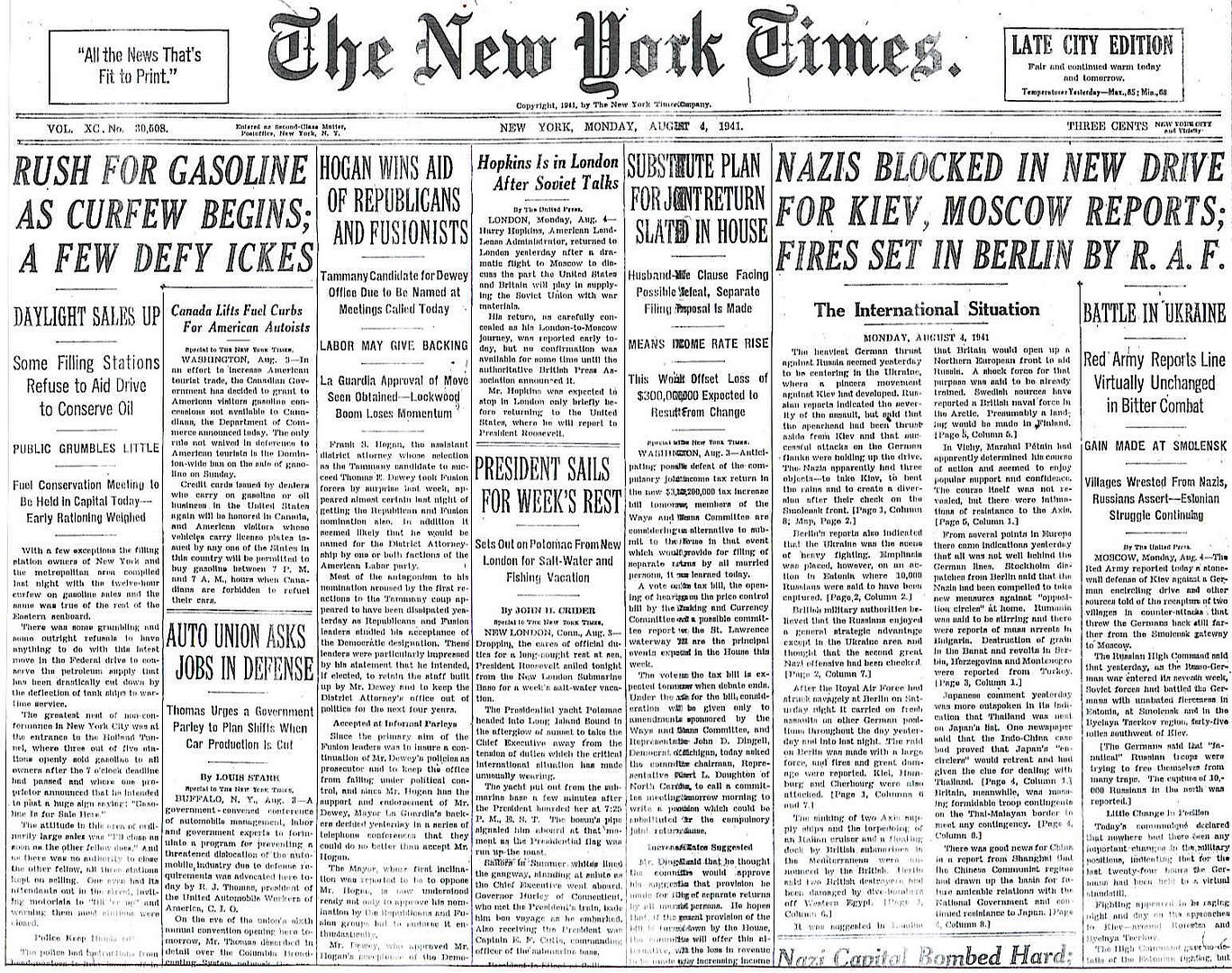
Posted on 08/04/2011 5:20:45 AM PDT by Homer_J_Simpson

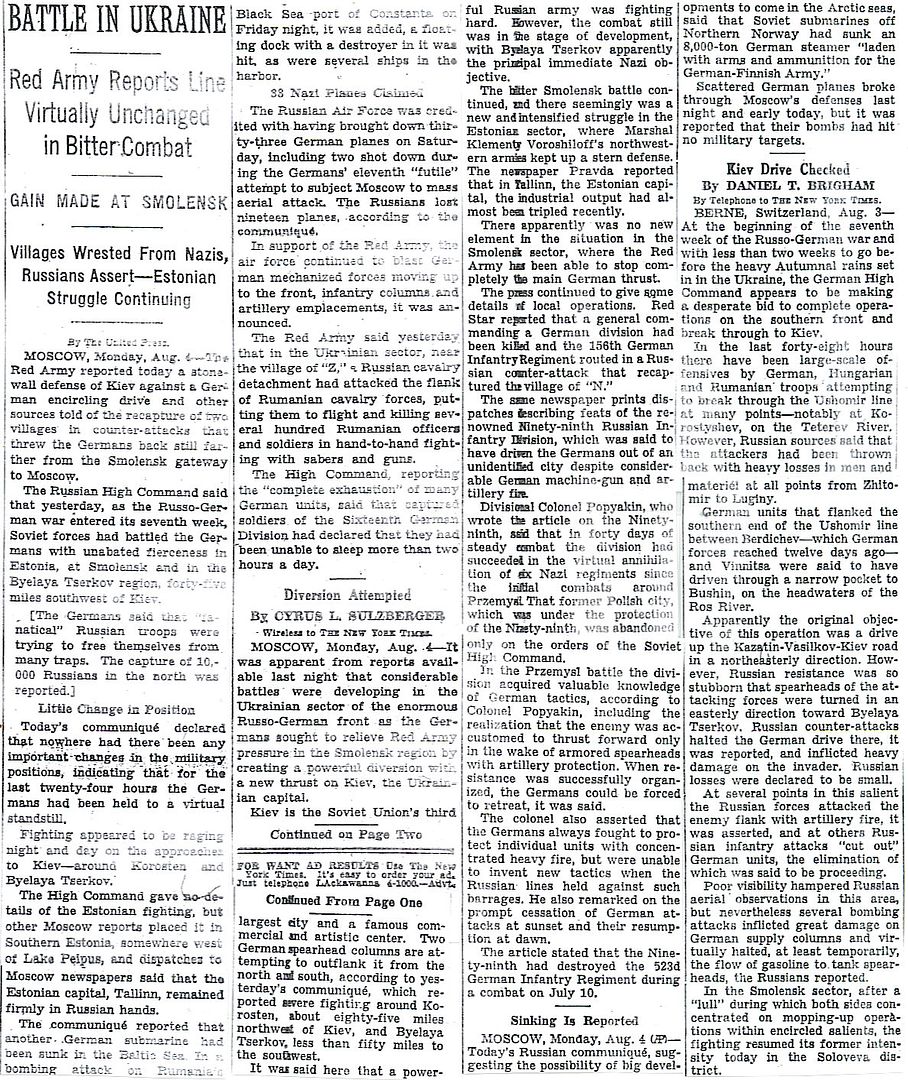
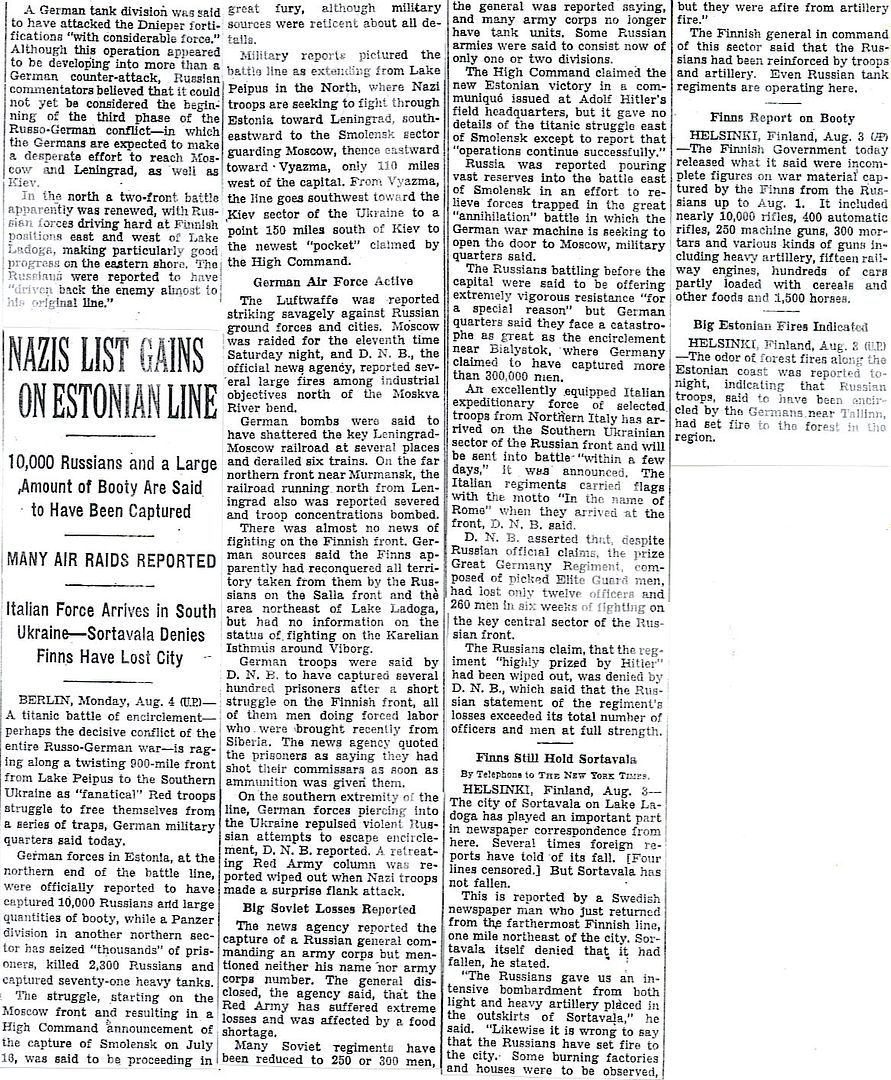
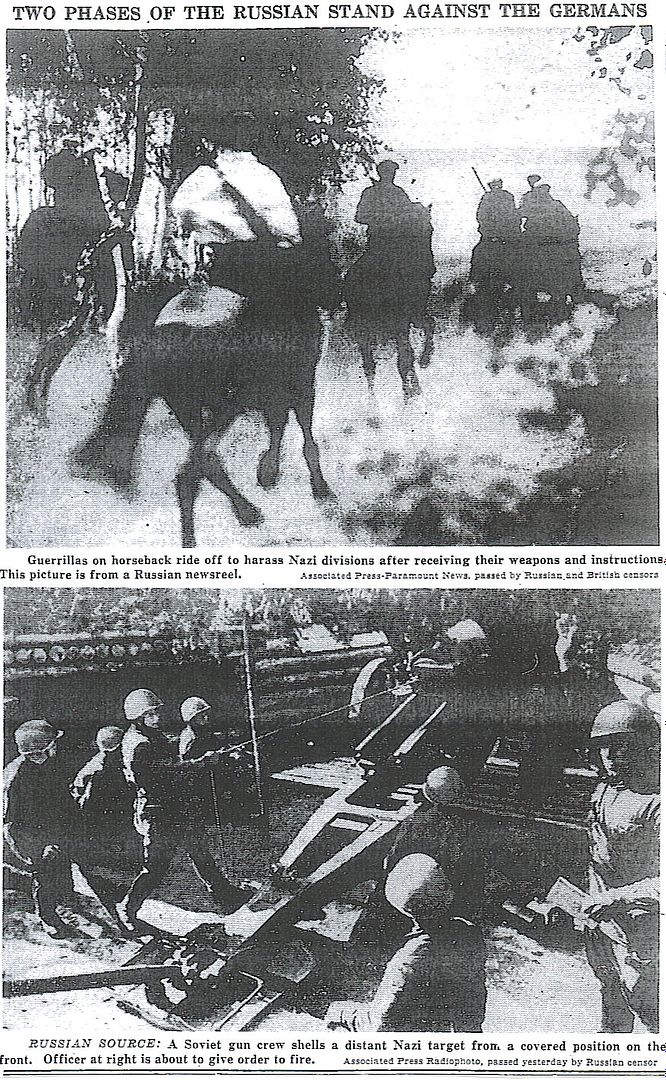
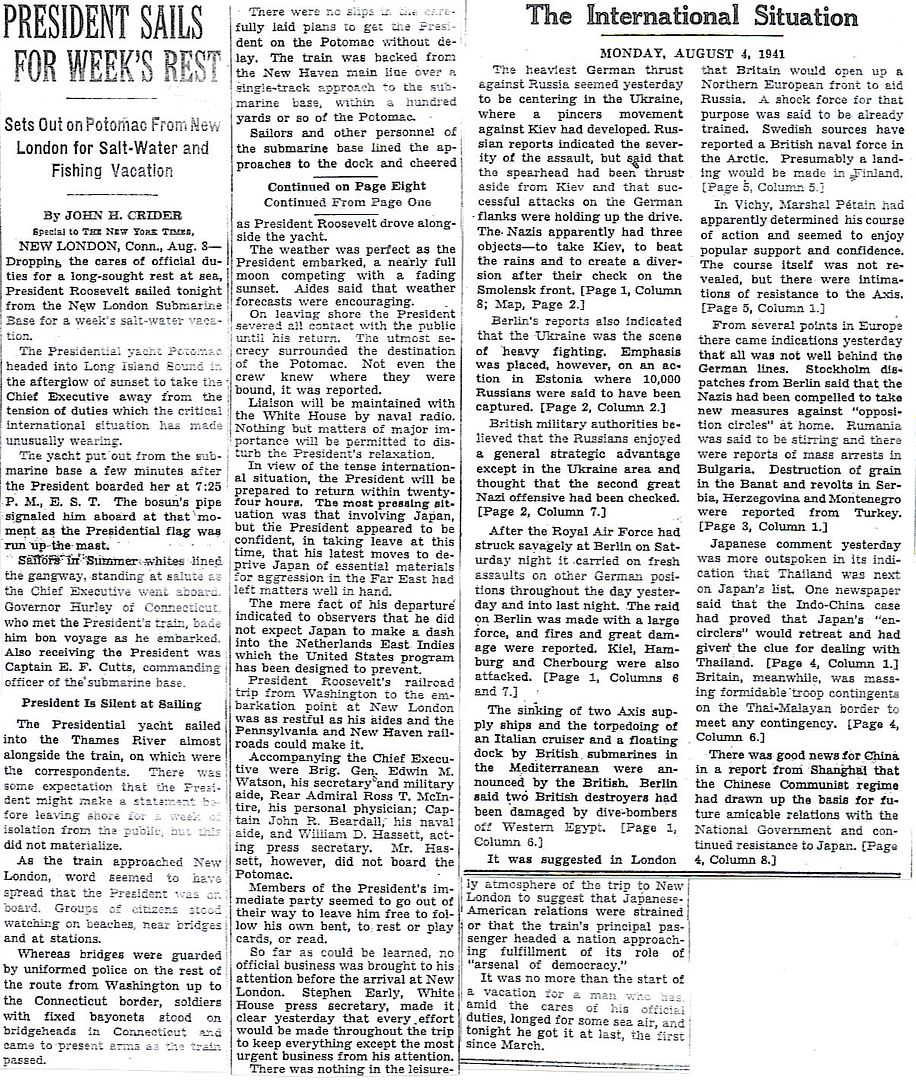

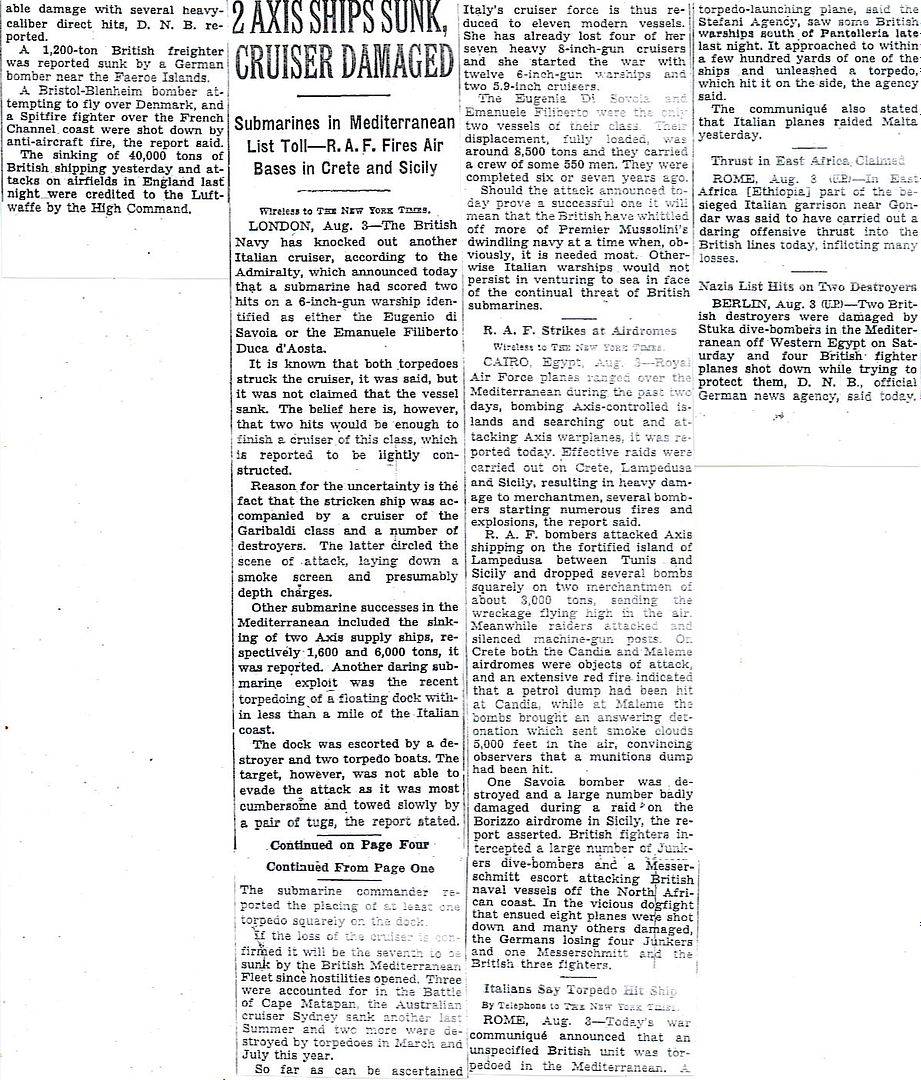


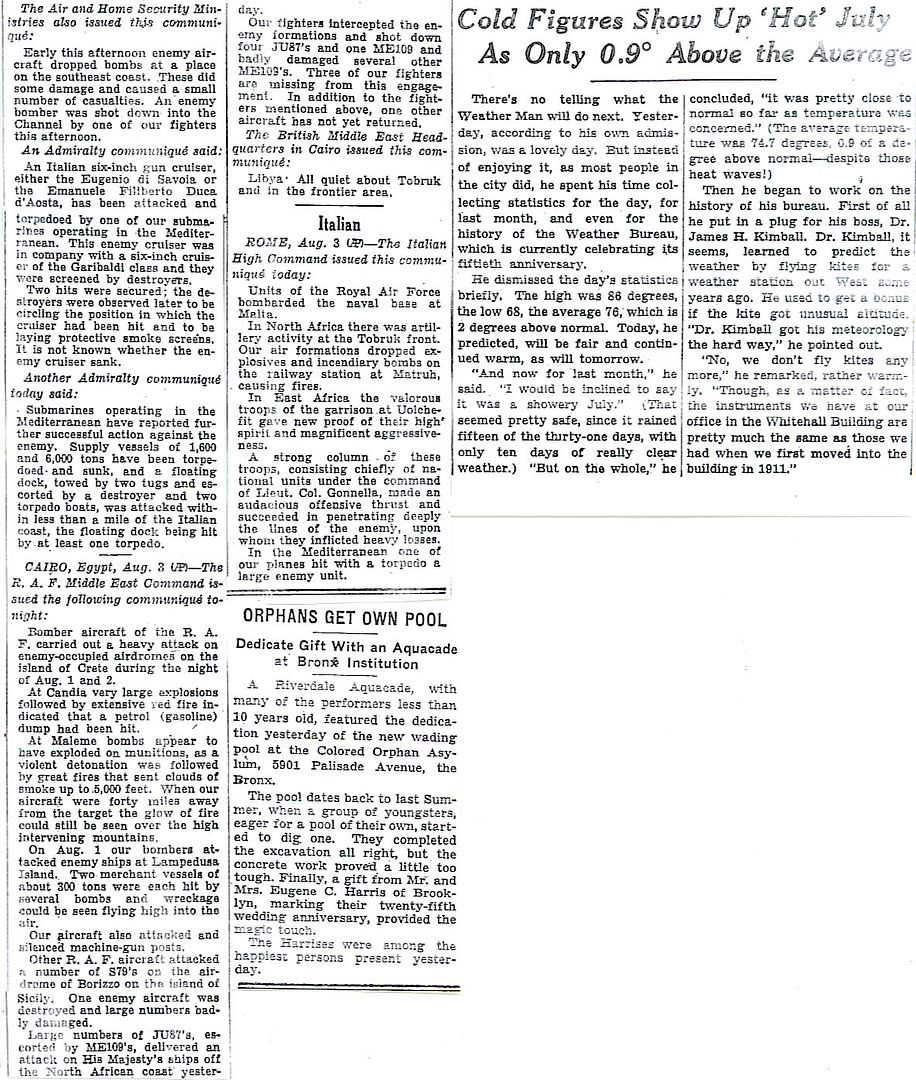
http://www.onwar.com/chrono/1941/aug41/f04aug41.htm
British carrier planes raid Tromso
Monday, August 4, 1941 www.onwar.com
In Norway... A small air raid by planes from the British carrier Victorious is launched against Tromso.
http://homepage.ntlworld.com/andrew.etherington/month/thismonth/04.htm
August 4th, 1941
UNITED KINGDOM: Minesweeper HMS Sidmouth commissioned. (Dave Shirlaw)
VICHY FRANCE: The government indicates that it will refuse military facilities to the Axis in North Africa. (Dave Shirlaw)
GERMANY: Guderian meets with Hitler and tells him that he believes the Soviet Army is scraping the bottom of its manpower barrel. (Peter Kilduff)(140)
U-523 laid down. (Dave Shirlaw)
CANADA: Minesweeper HMCS Malpeque commissioned. Corvette HMCS Battleford arrived Halifax from builder Montreal, Province of Quebec. (Dave Shirlaw)
U.S.A.: Washington: The US makes a formal commitment to send military supplies to the USSR. The Soviet Ambassador, Mr Oumansky, has welcomed the acceleration of US supplies as “an expression of confidence” that US aid would correspond to Soviet needs.
The US decision reveals a shift in policy by President Roosevelt. In the first days after the Nazi invasion of Russia on 22 June, he was reluctant to commit supplies to Russia, as he was advised that the Red Army would only hold out for a few weeks.
The US presidential yacht USS Potomac (AG-25), bearing President Franklin D Roosevelt, and the tender USS Calypso (AG-35) sail from Point Judith, Rhode Island to South Dartmouth, Massachusetts where Crown Princess Martha of Norway and her party board. After a day of fishing, the guests are put ashore and the two ships sail to Menemsha Bight, Vineyard Sound, Massachusetts where they join the heavy cruisers USS Augusta (CA-31) and USS Tuscaloosa (CA-37) and 5 destroyers.
Amphibious manoeuvres involving the US 1st Marine Division and the Army’s 1st Division begin at New River, North Carolina. Also involved is the aircraft escort vessel USS Long Island (AVG-1); the aircraft from the ship provide close air support for the “invaders.”
The first Ryan NR-1 trainer is delivered to NAS Jacksonville, Florida for primary flight training of the USN. (Jack McKillop)
Light cruiser USS Houston laid down. (Dave Shirlaw)
ATLANTIC OCEAN: At 2055, the Robert Max was stopped by two shots across her bow by U-126 near the Azores and was sunk two hours later by 17 rounds from the deck gun and gunfire after the crew was allowed to leave their ship
in a lifeboat. They were questioned by the Germans, who offered cigarettes, gave them the course to San Miguel and wished good luck before leaving the area. The survivors reached the Azores after three days and were repatriated from Oporto to Grand Bank by the British sailing vessel James and Stanley. (Dave Shirlaw)
ORPHANS GET OWN POOL
—————The pool dates back to last summer, when a group of youngsters eager for a pool of their own, started to dig one. They completed the excavation all right but the concrete work proved a little too tough...................
PRESIDENT SALES FOR A WEEKS REST
Good thing that FDR is getting a little vacation cruise in!
January-March 1941:
"70,000 displaced Polish Jews are forced into the Warsaw Ghetto.
January-August 1941:
About 13,000 Jews in the Warsaw Ghetto, and 5000 Jews in the Lódz Ghetto, die of starvation.
June-August 1941:
Numerous pogroms in occupied Russian territories.
June-November 1941:
Fourteen thousand Bosnian Jews are deported to regional camps.
July 1941:
British codebreakers monitoring radio traffic coming from German troops in the Soviet Union become aware of Nazi massacres of Soviet Jews.
Two thousand members of Minsk, Belorussia’s intelligentsia are executed by German troops in a nearby forest.
More than 2500 Jews are slaughtered at Zhitomir, Ukraine.
During an Einsatzkommando Aktion (murder operation) at Mielnica, Ukraine, a Jew named Abraham Weintraub hurls himself on a German officer and shatters the officer’s teeth. Weintraub is immediately shot.
In the Bialystok region of Poland, Nazis murder 300 members of the Jewish intelligentsia.
German killing squads begin to murder Jews remaining in Kishinev, Romania.
The Hungarian government undertakes a mass roundup of almost 18,000 Jewish refugees for deportation to Kamenets-Podolski, Ukraine.
Twenty-two-year-old Jew Haya Dzienciolski finds a pistol, leaves Novogrudok, Ukraine, and helps to organize a group of young partisans in nearby forests."

I like the cover story for the meeting with Churchill. Just a little salt-water vacation, nothing to see here.
“Good thing that FDR is getting a little vacation cruise in!”
The vacation was a ruse. He boarded a cruiser and went to Newfoundland to meet Churchill. The Presidential yacht with an FDR lookalike sailed around the coast deceiving the press.
Assignment to Pretzsch emptied the SS leadership school in Berlin-Charlottenburg and depleted the professional examination course of an SS criminal division. It drew in lower-and middle-ranking officers of the Security Police (the Gestapo and the criminal police), some of them passed on gratefully by their home regiments because they were considered too wild. The Waffen-SS, the small but growing SS army, contributed enlisted men. High-ranking bureaucrats within the shadowy Reich Security Main Office, an internal SS security agency, were posted to Pretzsch as well. They had been handpicked for leadership positions by Obergruppenführer Reinhard Heydrich, the head of the RSHA and the second most powerful man in the SS, and his superior Heinrich Himmler, the Reichsführer-SS.
Most of these handpicked leaders were lawyers, and a few were physicians or educators; most had earned doctoral degrees. Among the more exotic specimens were Otto Ohlendorf, a handsome but argumentative young economist who had fallen into disfavor with Himmler; Paul Blobel, a rawboned, high-strung, frequently drunken architect; Arthur Nebe, a former vice squad detective and Gestapo head who had enthusiastically volunteered; and Karl Jäger, a brutal fifty-three-year-old secret police commander. A reserve battalion of the regular German Order Police (uniformed urban, rural and municipal police) completed the Pretzsch roster.
Soon the men learned that they would be assigned to an Einsatzgruppe —a task force. Einsatz units—groups and commandos—had followed the German army into Austria, Czechoslovakia and Poland when Germany had invaded those countries successively in 1938 and 1939. Einsatzgruppen secured occupied territories in advance of civilian administrators. They confiscated weapons and gathered incriminating documents, tracked down and arrested people the SS considered politically unreliable—and systematically murdered the occupied country’s political, educational, religious and intellectual leadership. Since Germany had concluded a nonaggression pact with the Soviet Union in August 1939, many of the candidates at Pretzsch assumed they would be assigned to follow the Wehrmacht into England. Some of them had previously trained to just that end. The three-week course at Pretzsch in June 1941 involved only minimal training. Bruno Streckenbach, one man remembered, told the new Einsatzgruppen “that this was a war assignment which would be concluded by December at the latest.” Another recalled hearing from Stahlecker, the newly appointed chief of Einsatzgruppe A, that “we would be putting down resistance behind the troop lines, protecting and pacifying the rear army area (the word ‘pacify’ was used very frequently) and hence keeping the area behind the front clear…. Stahlecker also told us we would have to conquer our weaker selves and that what was needed were tough men who understood how to carry out orders. He also said to us that anyone who thought that he would not be able to withstand the stresses and psychological strains that lay ahead could report to him immediately afterwards.”
The men sat through familiar lectures on honor and duty and the subhuman nature of the people they would be asked to corral. They conducted “terrain exercises,” which one of them dismissed as “games of hide and seek.” The military training, another remembered, “was very brief. It was limited to firing of weapons. The men and the NCOs had the opportunity to go on a range and fire their weapons. At that time no intensive military training was possible, because the physical condition of the men didn’t permit this in most cases;…all the men intended to be sent to an Einsatz were inoculated, and the results of this inoculation brought fever and weakness in its wake, so that military training was not possible.” Nor, evidently, was it necessary for accomplishing the work the Einsatzgruppen would do. Only near the end of their time in Pretzsch, a few days before they would march, did the men learn where they were going: Russia. The Third Reich was preparing a surprise attack against the Soviet Union, Operation Barbarossa, scheduled to begin on 22 June 1941. Behind the Wehrmacht as it invaded the U.S.S.R. from the west would follow four Einsatzgruppen.
Einsatzgruppe A, under forty-year-old SS-Brigadeführer Stahlecker, attached to Army Group North, would operate in the former Baltic states of Estonia, Latvia and Lithuania.
Einsatzgruppe B, under forty-six-year-old SS-Brigadeführer Arthur Nebe, attached to Army Group Center, would “pacify” Byelorussia.
Einsatzgruppe C, under forty-nine-year-old SS-Brigadeführer Dr. Otto Rasch, attached to Army Group South, would sweep northern and central Ukraine.
Einsatzgruppe D, under thirty-four-year-old SS-Standartenführer Otto Ohlendorf, attached to Eleventh Army, would operate in southwestern Ukraine (Bessarabia), southern Ukraine, the Crimea and the Caucasus.
The four task forces were further subdivided into a total of sixteen Sonderkommandos and Einsatzkommandos, the real operational units of the formations, answerable to the task force leaders but functionally independent. Blobel, for example, led Sonderkommando 4a of Rasch’s Einsatzgruppe C, operating through the Ukraine to Kiev and beyond; Jäger, the brutal, walrus-mustached secret policeman, led Einsatzkommando 3 of Stahlecker’s Einsatzgruppe A, operating throughout Lithuania.
Einsatzgruppe A, the largest of the four task forces, counted 990 personnel (divided into two Sonderkommandos and two Einsatzkommandos, including 340 Waffen-SS, 172 motorcycle riders, 18 administrators, 35 Security Service (SD) personnel, 41 Criminal Police, 89 State Police, 87 Auxiliary Police, 133 Order Police, 13 female secretaries and clerks, 51 interpreters, 3 teletype operators and 8 radio operators. Ohlendorf, whose Einsatzgruppe D, with a roll call of about 500, was the smallest of the four (but was subdivided into four Sonderkommandos and one Einsatzkommando), would testify that his task force “had 180 vehicles…. This large number of [trucks] shows that the Einsatzgruppe was fully motorized. The Waffen-SS…were equipped with automatic rifles. The others either had rifles or automatic rifles. I believe that is about the total equipment.” The fact that the Einsatzgruppen were fully motorized is significant: the Wehrmacht itself was only partly motorized in June 1941, with much of its artillery still horse-drawn. Himmler intended his Einsatzgruppen to succeed and made sure the units were properly outfitted.
No detailed record of Einsatzgruppen equipment has survived, but a military historian, French L. MacLean, offers a speculative list derived from standard German military practice. Basing his estimates on Einsatzgruppe A, MacLean puts the total number of vehicles per group at about 160, of which sixteen would have been motorcycles, some with sidecars. Another sixteen would have been staff cars, MacLean estimates, “leaving some 128 as cargo and troop-carrying trucks—most likely Opel ‘Blitz’ 3-ton types…. Some 63 trucks would have been used to transport Einsatzgruppe soldiers; 50 others would have been remaining to haul required supplies.” The four Einsatzkommandos of Einsatzgruppe A and the headquarters staff would have been issued field radios and possibly teletype machines for communication; radio messages that the British intercepted provide documentary evidence of Einsatzgruppen crimes.
For electricity, MacLean notes, the units would each have had at least one mobile generator, “most commonly a large 507-pound two-cylinder variety.” There is no mention among eyewitness accounts of earth-moving equipment such as bulldozers; MacLean issues each Einsatzkommando at least forty shovels for digging mass graves, and possibly surveying equipment to record sites. “Each group would have also had a large field range mounted on one of the trucks to provide food for the troops. All elements would have additionally carried their own ammunition, cold-weather heating stoves, medium-size tents, portable field desks and chairs, spare parts for vehicles, light sets, cooking and serving utensils, arms room supplies, a few days’ worth of rations and water, gas and petroleum products for the vehicles, and sundry other items required for living in the field.” Weapons, MacLean proposes, would have included Luger, Mauser Model 1910 and Walther P-38 pistols for officers and Mauser Kar 98b rifles for enlisted men. Machine pistols (“Bergmann 9mm Model 35/Is or MP 38s”) were commonly used by both officers and enlisted men. Machine guns would control perimeters; hand grenades would flush victims from hideouts. There was no need for large arms, MacLean concludes: “The mission of the Einsatzkommando, after all, was execution, not combat.”
This time around, the Reichsführer-SS wanted no Wehrmacht complaints about his Einsatzgruppen operations; with Hitler’s support he saw to it that the military signed off in advance. Hitler himself dictated the necessary paragraph in the formal “Instructions on Special Matters Attached to Directive No. 21 (Barbarossa),” which Field Marshal Wilhelm Keitel, chief of the Armed Forces High Command, issued on 13 March 1941: Within the field of operations of the army, in order to prepare the political and administrative organization, the Reichsführer-SS assumes on behalf of the Führer special tasks which arise from the necessity finally to settle the conflict between two opposing political systems. Within the framework of these duties the Reichsführer-SS acts independently and on his own responsibility. The “two opposing political systems” were Bolshevism, which Hitler and his Nazi leadership believed to be a Jewish conspiracy, and National Socialism. Negotiating the details of this order, Army Quartermaster Wagner and Heydrich agreed on 26 March 1941 that Heydrich’s task forces were “authorized within the frame of their assignment to carry out on their own responsibility executive measures concerning the civilian population.”“Special tasks” and “executive measures” were SS euphemisms for mass murder. By ceding to Himmler’s organization independent authority over civilians in the territories it would occupy upon the commencement of Barbarossa, the Wehrmacht was knowingly colluding in atrocity. It did so partly because it accepted Hitler’s argument that “Jewish” Bolshevism was a fundamental threat to the German state, if not to civilization itself—and partly because Hitler bought it off with medals and promotions.
A general attending a March 1941 speech to several hundred Barbarossa commanding officers and chiefs of staff heard Hitler invoke a “clash between two ideologies.” Bolshevism, the Führer claimed, was “the equivalent of social delinquency. Communism is a tremendous danger for the future. We must get away from the point of view of soldierly comradeship [between opposing armies]. The Communist is from first to last no comrade. It is a war of extermination.” To be exterminated were “Bolshevik commissars and the Communist intelligentsia…. Commissars and the NKVD [i.e., Soviet secret police] people are criminals and must be treated as such.” The political purges of the previous decade in the U.S.S.R. gave weight to Hitler’s assertions; the German military was keenly aware that the NKVD purges had decimated the ranks of Red Army officers. “Out of eighty members of the 1934 Military Soviet,” writes Barbarossa historian Alan Clark, “only five were left in September 1938. All eleven Deputy Commissars for Defense were eliminated. Every commander of a military district…had been executed by the summer of 1938. Thirteen out of fifteen army commanders, fifty-seven out of eighty-five corps commanders, 110 out of 195 divisional commanders, 220 out of 406 brigade commanders, were executed. But the greatest numerical loss was borne in the Soviet officer corps from the rank of colonel downward and extending to company commander level.” From the point of view of a German officer, it would not be wise to lose the war.
The final components of Wehrmacht capitulation to SS operations in the war zone were assembled in further negotiations in May 1941 between Quartermaster Wagner and Walter Schellenberg, the polished, diplomatic SS officer who directed the counterespionage section of Heydrich’s RSHA. The Einsatzgruppen, Wagner had agreed, would operate even in the front-line areas (under Wehrmacht supervision) as well as completely independently behind the lines, with logistic support—quarters, fuel, rations—from the army. “This is the first time these special units will have been engaged at the front,” Heydrich had emphasized when he briefed Schellenberg conspiratorially before the negotiations began; “every one of their members will have the opportunity to prove himself and to earn a decoration. This should finally dispel the false impression that the staff of the executive departments are cowards who have got themselves safe posts out of the fighting line. This is extremely important, because it will strengthen our position in relation to the Wehrmacht.” If the Einsatzgruppen were ideological vanguards, they would also be instruments of bureaucratic infighting—of which Heydrich was a master.
Further support for the Einsatzgruppen came on 6 June 1941, when the army high command (OKH, Oberkommando des Heeres) issued its Commissar Order. Written distribution of this notorious order was confined to a few senior officers, who passed it along orally to their subordinates. The Communist political commissars, in the OKH’s eyes, were “bearers of the Jewish-Bolshevik worldview” within the Red Army and the “initiators of barbaric, Asiatic methods of combat.” They could be expected to visit special cruelty upon German POWs, the Commissar Order asserted, and should therefore be shot on capture. Other Soviet functionaries could be sorted into those who were active opponents of Germany (also to be shot on capture) and those who were not (who might be spared). Doubtful cases were to be handed over to the Einsatzgruppen. With the Commissar Order, Keitel asserted in a postwar deposition, Hitler was clearing the way “for Himmler to become, alongside the Wehrmacht, a key factor in the conduct of the war in the East. The justification for this move was sought in the claim that the Soviet government had not ratified the ‘Hague Agreement’ of 1907 or the Geneva accords and had intentionally set itself above the conventions of international law; their breach relieved us of our corresponding obligations.”
On 17 June 1941, a day or two after Streckenbach told the men in Pretzsch about Barbarossa, Heydrich ordered the chiefs of the Einsatzgruppen and their commandos to Berlin, to RSHA headquarters at No. 8 Prinz Albrechtstrasse, where he briefed them further on their impending mission. Erwin Schulz, who had led an Einsatzkommando in Czechoslovakia in 1938 and who had just been appointed to lead Einsatzkommando 5 (EG C), remembered Heydrich using many of the same arguments Hitler had used with the Wehrmacht leadership. “The fight which would soon take place would be the hardest and most bitter the German people have ever gone through,” Schulz testified Heydrich told them. “In the fight to come not only were people fighting against other people, but for the first time ideology was fighting against another ideology…. He explained that Bolshevism would not stop from using every means of fighting, as Lenin had already written; emphasizing in particular the part the partisans were to play, which Lenin and others had written about, and this could not be misunderstood. [He said] that everyone should be sure to understand that in this fight Jews would definitely take their part, and that in this fight everything was set at stake, and the side which gave in would be…overcome. For that reason all measures had to be taken against the Jews in particular. The experience in Poland had shown this.” Schulz emphasized in this postwar testimony, however, that neither in Berlin nor in Pretzsch had Heydrich and Streckenbach mentioned either the Commissar Order or the extermination of the Jews. At the outset of Barbarossa, at least, the work of the new Einsatzgruppen would be similar to the work of the Einsatzgruppen in Austria, Czechoslovakia and Poland—brutal enough work at that. Heydrich ordered four categories of enemies executed:
"[I] All officials of the Comintern (most of these will certainly be career politicians); [2] officials of senior and middle rank and 'extremists' in the [Communist] Party, the Central Committee, and the provincial and district committees; [3] the people's commissars; [4] Jews in the service of the party or the government; [as well as] other extremist elements (saboteurs, propagandists, snipers, assassins, agitators, etc.)."
Heydrich also told the Einsatzgruppen leaders to secretly encourage and not to interfere with “any purges that may be initiated by anti-Communist or anti-Jewish elements in the newly occupied territories.” Which meant that Jews who were not “in the service of the party or the government” were targeted from the outset; if the SS was not yet prepared to be seen murdering large numbers of Jews without at least minimal “political” justification, it was charged with the responsibility of organizing others to do so. (“The aim of Einsatzkommando 2 from the beginning,” commando leader Rudolf Lange would report from Latvia in January 1942, “was a radical solution of the Jewish problem through the execution of all Jews.”) The SS probably approached mass murder cautiously because of its past conflicts with the Wehrmacht; it needed first to assess whether the army on the scene would support and ignore the SS’s performance of its murderous “special tasks” in the occupied territories as the high command in Berlin had agreed to do. And in any case, as Streckenbach had informed the new Einsatzgruppen in Pretzsch, Russia was expected to be defeated by December. For now, elimination of the “Jewish-Bolshevik” leadership and intelligentsia; after the quick victory, there would be time to deal with the rest of the Eastern Jews.
But not only the Jews. A more grandiose vision than revenge against the Jews drove the Nazi elite. Himmler had refurbished a Saxon castle, Wewelsburg, for his SS leadership, which he considered “a knightly Order.” Sited on a bluff of the Alme River near Paderborn in western Germany, it looked out grandly across the Westphalian plain. One week before Barbarossa, the Reichsführer-SS assembled his top SS and police leadership at Wewelsburg for a three-day meeting. Heydrich attended; so did Heydrich’s stern, balding rival Kurt Daluege, the chief of the Order Police, and the Higher SS and Police Leaders Himmler had designated to assume civilian control of the occupied Soviet territories once the Wehrmacht moved on. Speaking to the assembled Gruppenführers in their elegant black uniforms, Himmler repeated Hitler’s arguments about an ultimate contest between ideologies and the necessity of seizing new living space—Lebensraum—for the Fatherland. He then put a number on what that seizure would mean. “It is a question of existence,” he said, “thus it will be a racial struggle of pitiless severity, in the course of which 20 to 30 million Slavs and Jews will perish through military actions and crises of food supply.” In Himmler’s vision, the Nazi plan for Lebensraum meant clearing the Soviet Union of its indigenous population all the way to the Urals through war, murder, enslavement and deliberate starvation. Heydrich inspected his troops immediately before they moved out. “On that day of inspection,” Erwin Schulz recalled, the Einsatzgruppen commandos “were gathered together on the marching field…and lined up in the open square.” Heydrich hurried his walk through the ranks; a rainstorm was coming that might ground his plane and he needed to return to Berlin. “And then the inspection took place by Heydrich,” Schulz concludes, “and after the inspection they marched out of this place down the road.”
No more sinister phalanx was ever loosed upon the world.
Masters of Death by Richard Rhodes

Soviet Union Center, Vitebsk railway station .- Transport of captured Soviet soldiers in open freight cars 1941-09-21
Two men with raised arms are controlled by a German soldier Two disguised as peaceful civilians bolschiwistische soldiers were unearthed in a cornfield. The capture of these snipers and saboteurs will put a stop to their recklessness.
Soviet Union-North .- shooting of men ("Partisans"), men sitting on the floor, in the background of German soldiers and officers Sept 1941
Soviet Union-North .- shooting of men ("Partisans"), men sitting on the floor, in the background of German soldiers and officers Sept 1941
Soviet Union-North .- shooting of men ("Partisans"), firing squad at the execution of six men 1941-09-01
Jews in Mogilev-summer 1941
Russia-executed partisans 1943
Soviet partisans hanged .- (after 21/01/1943). Signs on the gallows "We are bandits, we have murdered not only German soldiers but also Russian citizens and plundered" (written in German and Russian) and prohibited "photographing!
Russian POWs Survivors of Bialystock Army, June / July 1941
Soviet Union, Soviet prisoners of war .- mid-soldiers with Jewish star Creation Date: 1941-08-01
Least we think that being US President was all work and no play for 59 year-old FDR:
"Crown Princess Martha was a frequent visitor to the White House.
The thirty-nine-year-old princess and her three children—Princesses Ragnhild and Astrid and Prince Harald, heir apparent to the Norwegian throne—were given asylum in the United States by the President following the Nazi invasion of Norway in April 1940.
Her husband, Crown Prince Olav—the future King of Norway—remained Norway—remained in London.
In 1999 their son Harald is King of Norway.
On many occasions in 1941, Princess Martha turned up at the White House on the eve of momentous world events—most often when First Lady Eleanor Roosevelt was out of town.
On June 15, 1941, Martha was with FDR just days before the German invasion of Russia."And it was the princess who traveled with Roosevelt aboard the presidential yacht, USS Potomac, in August when FDR sailed to Newfoundland and the Atlantic Charter conference with Winston Churchill."
Stinnett, Robert (1999). Day of Deceit; Free Press.
Looks like a couple of guys in the firing squad are left handed. Also looks like a couple of the Russian POWs were really close.
Disclaimer: Opinions posted on Free Republic are those of the individual posters and do not necessarily represent the opinion of Free Republic or its management. All materials posted herein are protected by copyright law and the exemption for fair use of copyrighted works.